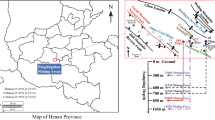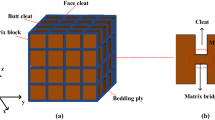Abstract
Although the relationships among stress, effective porosity and permeability of coal are a fundamental research topic that has been studied for decades and are widely used in analyzing the mechanical behavior of coal seams and predicting coalbed methane production, most relevant studies are based on idealized models and do not consider the influence of natural fracture distributions. To obtain a comprehensive understanding of the interrelationships among stress, effective porosity and permeability of coal, a series of effective porosity and permeability determinations have been conducted under different overburden stresses using an automated permeameter–porosimeter considering the directional distribution of natural fractures in coal. The experimental results show that the directional distribution of natural fractures provides a substantial contribution to the anisotropy of the effective porosity and absolute permeability of coal, which exponentially decrease with increasing overburden stress. An existing permeability model was modified to reflect the influence of the natural fracture distribution on the power law relationship between effective porosity and permeability, i.e., the exponent is not constant, but a variable related to the natural fracture distribution. The anisotropic effective porosity sensitivity and stress sensitivity of coal are also discussed, and the coal mass is shown to have the highest effective porosity sensitivity and lowest stress sensitivity in the direction perpendicular to the bedding planes compared to those in other directions.






Similar content being viewed by others
References
Barton N, Bandis S, Bakhtar K (1985) Strength, deformation and conductivity coupling of rock joints. Int J Rock Mech Min Sci Geomech Abstr 22(3):121–140
Beamish BB, Crosdale PJ (1998) Instantaneous outbursts in underground coal mines: an overview and association with coal type. Int J Coal Geol 35(1):27–55
Cappa F, Rutqvist J (2011) Modeling of coupled deformation and permeability evolution during fault reactivation induced by deep underground injection of CO2. Int J Greenhouse Gas Control 5(2):336–346
Close JC (1993) Natural fractures in coal. In: Law BE, Rice DD (eds) Hydrocarbons from coal. AAPG Studies in Geology, Tulsa, pp 119–132
Connell LD, Lu M, Pan Z (2010) An analytical coal permeability model for tri-axial strain and stress conditions. Int J Coal Geol 84(2):103–114
Cui X, Bustin RM (2005) Volumetric strain associated with methane desorption and its impact on coalbed gas production from deep coal seams. AAPG Bull 89(9):1181–1202
Davidson RM, Sloss LL, Clarke LB (1995) Coalbed methane extraction. IEA Coal Research, London
Enever J, Henning A (1997) The relationship between permeability and effective stress for Australian coal and its implications with respect to coalbed methane exploration and reservoir model. In: Proceedings of the 1997 International Coalbed Methane Symposium, University of Alabama, Tuscaloosa, Alabama, USA, 1997, pp 13–22
Flores RM (1998) Coalbed methane: from hazard to resource. Int J Coal Geol 35(1):3–26
Gilman A, Beckie R (2000) Flow of coal-bed methane to a gallery. Transp Porous Media 41(1):1–16
Gonzalez-Nicieza C, Alvarez-Fernandez MI, Prendes-Gero MB, Pizarro-Garcia C, Oliva-Gonzalez AO (2014) An experiment-based assessment of the feasibility of the CO2 geological storage in unexploited coal beds in northern Spain. Environ Earth Sci 71(8):3673–3684
Gray I (1987) Reservoir engineering in coal seams: part 1-The physical process of gas storage and movement in coal seams. SPE Reserv Eng 2(1):28–34
Gu F, Chalaturnyk R (2005) Analysis of coalbed methane production by reservoir and geomechanical coupling simulation. J Can Pet Technol 44(10):33–42
Gu F, Chalaturnyk R (2010) Effective porosity and permeability models considering anisotropy and discontinuity of coalbeds and application in coupled simulation. J Petrol Sci Eng 74(3):113–131
Harpalani SS (1999) Compressibility of coal and its impact on gas production from coalbed reservoirs. In: Vail Rocks 1999 The 37th US Rock Mechanics Symposium (USRMS), Vail, Colorado, USA. Rock Mechanics for Industry, Amadei B, Kranz RL, Scott GA, Smeallie PH(Eds.), American Rock Mechanics Association pp. 301–308
Hou Z, Gou Y, Taron J, Gorke UJ, Kolditz O (2012) Thermo-hydro-mechanical modeling of carbon dioxide injection for enhanced gas-recovery (CO2-EGR): a benchmarking study for code comparison. Environ Earth Sci 67(2):549–561
Jaeger JC, Cook NG, Zimmerman R (2007) Fundamentals of rock mechanics. Blackwell, Singapore
Jones SC (1972) A rapid accurate unsteady-state Klinkenberg permeameter. Soc Petrol Eng J 12(5):383–397
Jones FO Jr (1975) A laboratory study of the effects of confining pressure on fracture flow and storage capacity in carbonate rocks. J Petrol Technol 27(1):21–27
Lagny C (2014) The emissions of gases from abandoned mines: role of atmospheric pressure changes and air temperature on the surface. Environ Earth Sci 71(2):923–929
Liu H, Rutqvist J (2010) A new coal-permeability model: internal swelling stress and fracture–matrix interaction. Transp Porous Media 82(1):157–171
Liu J, Elsworth D, Brady B (1999) Linking stress-dependent effective porosity and hydraulic conductivity fields to RMR. Int J Rock Mech Min Sci 36(5):581–596
Liu J, Chen Z, Elsworth D, Miao X, Mao X (2010) Linking gas-sorption induced changes in coal permeability to directional strains through a modulus reduction ratio. Int J Coal Geol 83(1):21–30
Ma Q, Harpalani S, Liu S (2011) A simplified permeability model for coalbed methane reservoirs based on matchstick strain and constant volume theory. Int J Coal Geol 85(1):43–48
McKee C, Bumb A, Koenig R (1988) Stress-dependent effective porosity and permeability of coal and other geologic formations. SPE Form Eval 3(1):81–91
Nelson CR (2000) Effects of geologic variables on cleat effective porosity trends in coalbed gas reservoirs. In: SPE/CERI Gas Technology Symposium, Calgary, Alberta, Canada. Society of Petroleum Engineers pp 651–655
Palmer I (2009) Permeability changes in coal: analytical modeling. Int J Coal Geol 77(1):119–126
Palmer I, Mansoori J (1998) How permeability depends on stress and pore pressure in coalbeds: a new model. SPE Reserv Eval Eng 1(6):539–544
Pan Z, Connell LD (2011) Modelling of anisotropic coal swelling and its impact on permeability behaviour for primary and enhanced coalbed methane recovery. Int J Coal Geol 85(3):257–267
Pattison C, Fielding C, McWatters R, Hamilton L (1996) Nature and origin of fractures in Permian coals from the Bowen Basin, Queensland, Australia. Geological Society, London, Special Publications 109(1):133–150
Perera M, Ranjith P, Choi S-K, Bouazza A, Kodikara J, Airey D (2011) A review of coal properties pertinent to carbon dioxide sequestration in coal seams: with special reference to Victorian brown coals. Environ Earth Sci 64(1):223–235
Ried G, Towler B, Harris H (1992) Simulation and economics of coalbed methane production in the Powder River Basin. In: SPE Rocky Mountain Regional Meeting, Society of Petroleum Engineers, Casper, Wyoming, USA
Robertson EP, Christiansen RL (2008) A permeability model for coal and other fractured sorptive-elastic media. SPE J 13(3):314–324
Seidle JR, Huitt LG (1995) Experimental measurement of coal matrix shrinkage due to gas desorption and implications for cleat permeability increases. In: International Meeting on Petroleum Engineering, 14–17 November, Beijing, China, pp 575–582
Seidle J, Jeansonne M, Erickson D (1992) Application of matchstick geometry to stress dependent permeability in coals. In: SPE rocky mountain regional meeting, Society of Petroleum Engineers, Casper, Wyoming, USA
Shi JQ, Durucan S (2005) A model for changes in coalbed permeability during primary and enhanced methane recovery. SPE Reserv Eval Eng 8(4):291–299
Shi JQ, Durucan S, Shimada S (2014) How gas adsorption and swelling affects permeability of coal: a new modelling approach for analysing laboratory test data. Int J Coal Geol 128:131–139
Somerton WH, Söylemezoḡlu IM, Dudley RC (1975) Effect of stress on permeability of coal. Int J Rock Mech Min Sci Geomech Abstr 12(5):129–145
Sparks D, McLendon T, Saulsberry J, Lambert S (1995) The effects of stress on coalbed reservoir performance, Black Warrior Basin, USA. In: Society of Petroleum Engineers. Annual technical conference, Dallas Texas, pp 339–351
Szwilski AB (1984) Determination of the anisotropic elastic moduli of coal. Int J Rock Mech Min Sci Geomech Abstr 21(1):3–12
Van Golf-Racht TD (1982) Fundamentals of fractured reservoir engineering. Developments in petroleum science, 12th edn. Elsevier, Amsterdam
Wang G, Massarotto P, Rudolph V (2009) An improved permeability model of coal for coalbed methane recovery and CO2 geosequestration. Int J Coal Geol 77(1):127–136
Wang S, Elsworth D, Liu J (2011) Permeability evolution in fractured coal: the roles of fracture geometry and water-content. Int J Coal Geol 87:13–25
Wang S, Elsworth D, Liu J (2012) A mechanistic model for permeability evolution in fractured sorbing media. J Geophys Res 117(B06205):1–17. doi:10.1029/2011JB008855
Wang JJ, Tang DZ, Xu H, Yi J, Yi YJ (2013) Stress sensitivity of coal samples in terms of anisotropy. J Coal Sci Eng (China) 19(2):203–209
Wang K, Zang J, Wang G, Zhou A (2014) Anisotropic permeability evolution of coal with effective stress variation and gas sorption: model development and analysis. Int J Coal Geol 130:53–65
Wold MB, Jeffrey RG (1999) A comparison of coal seam directional permeability as measured in laboratory core tests and in well interference tests. In: SPE Rocky Mountain regional meeting, Richardson TX, ETATS-UNIS, pp 185–193
Zimmerman RW, Somerton WH, King MS (1986) Compressibility of porous rocks. J Geophys Res: Solid Earth (1978–2012) 91(B12):12765–12777
Acknowledgments
This research was funded by the State Key Basic Research Program of China (No. 2011CB201201) and the National Natural Science Foundation of China (No. 51204113, 51134018).
Author information
Authors and Affiliations
Corresponding author
Rights and permissions
About this article
Cite this article
Zhang, Z., Zhang, R., Xie, H. et al. The relationships among stress, effective porosity and permeability of coal considering the distribution of natural fractures: theoretical and experimental analyses. Environ Earth Sci 73, 5997–6007 (2015). https://doi.org/10.1007/s12665-015-4280-3
Received:
Accepted:
Published:
Issue Date:
DOI: https://doi.org/10.1007/s12665-015-4280-3




